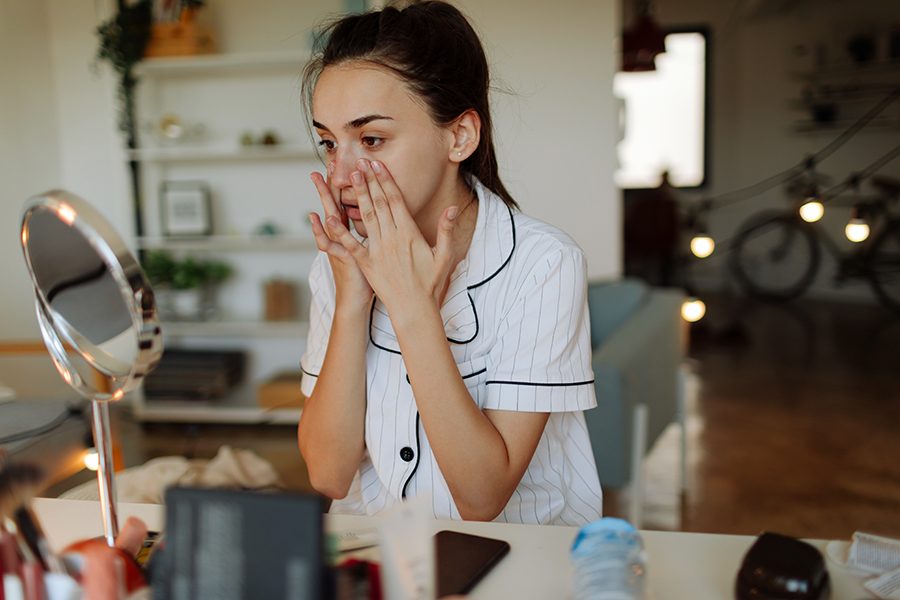Ask the Expert: How Do I Take Better Care of My Skin in the Winter?
As the temperatures drop, and the air becomes cold and dry, follow this easy five-step winter skincare routine.

Photo via Getty Images
The change in seasons is a time of transition. For New Englanders who get to experience the beauty of all four seasons (some a little longer than others), it means we’re really good at transitioning—from pulling out the Bean boots to winterizing boats, and yes, even in how we take care of our skin and bodies. Everything deserves a revamp as a new season rolls around.
When it comes to maintaining that dewy, moisturized skin the summer weather so kindly fosters, all it takes is a couple of tweaks here and there. Below you’ll find an easy five-step winter skincare routine from Tufts Medical Center dermatologist Dr. Isha Tiernan, for skin you won’t have to hide behind a scarf all season long—unless a nor’easter blows through, and then we highly recommend it.
1. Moisturize
First and foremost, the most important thing to do in the winter is to moisturize. You might be thinking that you already have this down pat, but Tiernan says to forget about your pump bottles of lotion and moisturizer and to opt for thick creams. Her favorites include Aquaphor and Vaseline.
“Pump bottles have a little more alcohol and are inherently a bit more drying,” she explains. “If you’re in a rush, spray moisturizers are also a good option and can be put on in the shower.”
Moisturizing when the skin is still damp or wet is the key, Tiernan says, because it absorbs more quickly. Plus, if you suffer from itchy skin, or a skin condition, such as eczema, moisturizers are going to be your saving grace.
2. SPF in the morning, humidifier at night
We may not see the sun for much of the winter, but it’s still there. “You’re still getting a lot of sun damage in the winter months,” Tiernan says. “UVA rays [the ultraviolet light from the sun causing long-term skin damage, aging, and wrinkles] penetrates windshields and goes right through the clouds. Do not neglect sunscreen in the morning part of your skincare routine.” Even more, during winter activities like skiing, sledding, or ice skating when the sun is reflecting off the ground, you’ll want to make sure you’re reapplying every 1-2 hours.
Similarly, there are things you can do at night to promote healthy skin during the winter, like sleeping with a humidifier. As soon as the heat is turned on in your home, the humidifier should be turned on as well. The hot air forced out of heating vents can cause skin to become extra dry and brittle, Tiernan explains. “They even have really cute ones now,” she adds.
3. Incorporate products with antioxidants
Antioxidants, at their core, are substances that inhibit oxidization, or the chemical reaction that can produce free radicals leading to cell damage. Free radicals can be produced from normal cell processes or from external sources like pollution, cigarette smoke, radiation, and medication. Antioxidants in skincare products include vitamins A, C, E, B3, and others.
While your diet should be rich in foods with antioxidants, topical skincare products can aid in the work your SPF is already doing, calm inflammation, and slow premature aging. Dr. Tiernan recommends focusing on vitamins C and E and to be sure you’re running the products past a dermatologist, because some aren’t as stable as others and won’t actually be able to produce the intended results.
She adds that products with vitamin A, also known as retinoids, are extremely popular, as they increase healthy cell turnover, repair the cellular structure of the skin, decrease oil production, and elicit collagen production. They can be very drying though, so Tiernan suggests using one every other day in the winter, and ensuring that you moisturize.
4. Give some extra TLC to your lips
Just as you wouldn’t forget to moisturize your skin, don’t forget about your pucker. Tiernan recommends “heavy-duty” options like Vaseline ointment to hydrate and lip sunscreen (yes, there’s such a thing) for protection. You can also find some chapsticks with SPF already in them. She adds to steer clear of fragrances and flavoring, as some people are not able to tolerate them well.
5. Limit hot showers
Although it is awfully tempting to soak under a hot shower for as long as possible when it’s cold and blustery outside, Tiernan says warm water is better than hot, and it’s best to limit showers to 10 minutes or less. Even more important than the water on your skin, you want to ensure you’re drinking plenty of fluids and staying hydrated. After all, true beauty starts from within.

